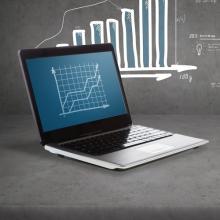
What comes to mind when you hear the word "analytics"? Maybe you picture a few graphs or charts depicting the last quarter's revenue with a nice blue arrow pointing "up." If so, you're not alone - many believe that analytics only involves data visualization, which is the gathering and displaying of information that allows business analysts to get a solid look at what happened at a given moment in the past.
Examining data to see what happened in the past is an important part of any analysis, but that's not all an analyst can do with the information. He or she should also be able to make predictions about how these numbers will look in the future, and recommend the next logical step for an organization - two things that strict data visualization can't accomplish.
Let's break down the main kinds of "analytics" and see how they can contribute to business value:
"It's crucial to assess raw data to gain key business insights."
Descriptive analytics
What is it?
The amount of data being generated on a daily basis is astounding. To cope with this, companies need tools to analyze that data and determine which areas of the business are most important to focus on. Descriptive analytics includes summarizing, "slicing and dicing" data and creating the aforementioned charts and graphs, otherwise known as data visualization.
Business intelligence tools like the kind offered by Tableau and Microsoft PowerBI fall under this category. Tableau, in particular, defines data visualization as the ability to present and organize information intuitively.
How do you use it?
Descriptive analytics uses data that's already been gathered to make a statement about the recent past. For instance, a furniture chain can easily delve into sales and revenue numbers. How many chairs were sold last month? What was the revenue in a specific region of the country? Using the answers to questions like these, business analysts can gain insights into revenue and the company's bottom line, and identify trends that might otherwise be hidden in an avalanche of data.
Predictive analytics
What is it?
This kind of analytics uses gathered data to make a statement about the future. Time series forecasting for sales or inventory planning falls in this category. But with data mining, companies can go beyond aggregate forecasts, to predict what individual customers will do, which stores may run out of inventory, when specific roads will be congested and the like. Gartner describes predictive analytics as a technique that places emphasis on the business relevance of the insights generated.
How do you use it?
What can predictive analytics offer to an organization? Here's an easy example: The popular streaming service Netflix uses data mining strategies to predict its users' viewing habits. According to SmartDataCollective contributor Bernard Marr, data points like time of day, amount of time spent selecting movies and how many pauses occurred during a certain selection – along with user ratings – all contribute to Netflix's predictive algorithm. Netflix uses this algorithm to determine what a user will probably watch next.
Another appropriate example of predictive analytics was mentioned recently by The Predictive Analytics Times. As the U.S. presidential race heats up, the candidates' teams may use predictive modeling tools to make sure they are hitting the pressure points of the American public. What do people care about? What will they care about next week? How will they vote in November? Today's sophisticated campaigns crunch a wide range of data to identify the individual voters who can be swayed, versus those whose minds are made up.

Prescriptive analytics
What is it?
Prescriptive analytics is also concerned with the future – but instead of just predicting what will happen without intervention, this takes the analysis one pace further. Decision-based analytics, which is another term for prescriptive techniques, allows organizations to act on the data being analyzed, adapt quickly and better serve their markets, all the way down to individual customers. In other words, based on a company's raw data and predictions made in the previous step, a business analyst can fine tune how resources should be used. The simplest form of prescriptive analytics would be to say something along the lines of, "We've got a good prospect here – send them an offer!" But that's only the beginning of what you can do.
How do you use it?
The Netflix example spans both predictive and prescriptive analytics. Prescriptive analytics allows business analysts to parse through data and determine what customers are most likely to buy (or, in this particular example, watch) and then timely make those recommendations. Beyond Netflix, in a wider business setting, prescriptive tools and techniques – like Monte Carlo simulation and optimization – can be applied to find the best ways to use available resources, even when outcomes are uncertain. It's all about the decision-making.
The takeaway
Analytics isn't just about being able to see what the numbers are from the past. It's also important to make sure your company is using the right descriptive, predictive and prescriptive tools to make the proper business decisions. An effective combination of all three techniques will be a business analyst's best bet to making sure an organization uses its data to the fullest. For instance, with the Analytic Solver Platform, you can build a tool that will help you analyze, predict and prescribe solutions for your company.
